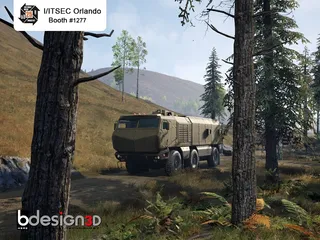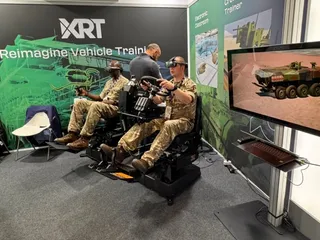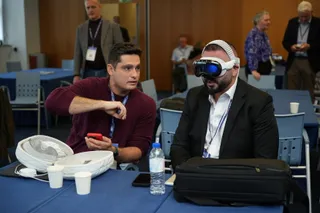Training Humans. Teaching Machines. The New Standard of Simulation Realism.
Contact Our Team
For more information about how Halldale can add value to your marketing and promotional campaigns or to discuss event exhibitor and sponsorship opportunities, contact our team to find out more
The Americas -
holly.foster@halldale.com
Rest of World -
jeremy@halldale.com
Sponsored Content
By B-Design3D (www.b-design3d.com)
From Training Readiness to Autonomous Readiness
For decades armed forces have relied on visual databases to prepare personnel for complex missions. The realism of those 3D environments has always defined the value of simulation. Now, as autonomy reshapes defense operations, realism must evolve again.
Autonomous ground vehicles, robotic logistics convoys, and AI-assisted mission systems are moving from concept to deployment. Training and validation for these platforms demand the same environmental fidelity long valued in manned training, but now optimized for machine and sensor perception, and algorithmic decision-making.
B-Design3D’s heritage in defense simulation meets recent advances in the automotive sector, where they build ultra-realistic 3D terrains for autonomous vehicle (AV) simulation, and Driver-in-the-Loop (DIL) training. By merging decades of military domain knowledge with cutting-edge commercial tools, they are delivering environments that are autonomy-ready, AI-enhanced, and technology-agnostic.
Defense Heritage Meets Autonomy
Across NATO and allied programs, the conversation around autonomy is accelerating. Future formations will include fleets of unmanned ground vehicles (UGVs) and semi-autonomous convoy systems capable of navigating unstructured terrain under human oversight.
Training and testing these systems require environments that can simultaneously support human immersion and machine validation. B-Design3D experience building Omniverse-compatible terrains for NVIDIA and other leading IGs provides exactly that: photorealistic 3D environments and accurate surface materials that enable dynamic conditions, challenging both human trainees and machine perception.
Techniques refined for sensor realism—LiDAR returns, camera exposure to conditions such as fog, glare, rain, reflections, and motion blur, and radar occlusion—are now directly applicable to defense needs such as autonomous and off-road mobility, obstacle detection, and AI-based route planning and optimization. The same realism that allows an autonomous car to interpret a complex intersection can help a robotic convoy navigate a contested valley.
Dual-Use Digital Twins
The strongest simulation ecosystems today are dual-use by design. The 3D terrains provided by B-Design3D for DIL training in the civil transportation sector, for instance, allow for the modeling of complex traffic situations, pedestrian movement, and emergency scenarios with precision derived from defense workflows. Those same digital twins can be repurposed to train heavy military vehicles for convoy or disaster-relief operations in urban environments.
Civil projects bring scale, data richness, and funding cycles that push realism forward. Defense programs benefit by adopting those assets and workflows, closing the gap between commercial and military simulation. The result is a virtuous loop: military standards strengthen civilian safety, and civilian complexity enhances military readiness.
The Agnostic Advantage
Modern defense customers face a constant integration challenge: legacy image generators on one end, next-generation visualization frameworks on the other. Lock-in slows innovation.
B-Design3D’s content strategy is graphic engine agnostic. Whether a program relies on a long-established military IG, a modern gaming engine like Unreal or Unity, or emerging ecosystems such as NVIDIA Omniverse, their proven workflows and cross-platform expertise allow them to migrate and optimize terrain content for each engine’s unique strengths, from real-time rendering to large-area simulation performance.
This agnostic approach ensures that new autonomy and AI initiatives can leverage the same verified datasets already used in traditional training, creating a unified visual baseline across constructive, virtual, and live domains. Terrain becomes the common language connecting programs, not a technical barrier separating them.
AI-Driven Modeling at Scale
The demand for global, high-resolution environments is expanding faster than manual workflows can support. To meet that need, B-Design3D has integrated AI and machine learning throughout the modeling pipeline.
Algorithms now classify satellite and aerial imagery, generate accurate geometry, and texture landscapes automatically, allowing their 3D artists to focus on mission-critical refinement. This combination of human expertise and AI acceleration delivers larger areas, higher detail, and faster turnaround, often leading to significantly more efficient production cycles.
For defense customers, that translates into scalable realism: terrains that can be updated rapidly for new theaters, exercises, or autonomy trials while staying within program budgets. AI does not replace craftsmanship; it multiplies it.
Preparing for the Next Decade of Simulation
As defense organizations embrace autonomy, simulation content must serve dual purposes: to both train people and to teach machines. 3D simulated environments must represent not only what a human sees, but how an algorithm perceives and reacts.
By combining decades of defense simulation experience, dual-use insight from commercial ADAS/AV, agnostic compatibility across engines and IGs, and AI-driven modeling efficiency, B-Design3D is creating the training fabric that connects today’s human-centered simulation to tomorrow’s autonomous battlefield.
Realism has always mattered. Now it matters to both the operator and the machine.
Meet with B-Design3D at I/ITSEC 2025, Booth# 1277
To schedule a meeting: info@b-design3d.com
B-Design3D is a world-leading provider of 3D Environments ("Digital Twins") and Terrain Databases for simulation systems for the past 25 years. With a perfect balance between realism and performance, our highly realistic 3D Environments and Digital Twins help our customers significantly enhance their user experience, machine learning and training immersiveness.
To find out more, visit: https://www.b-design3d.com/



